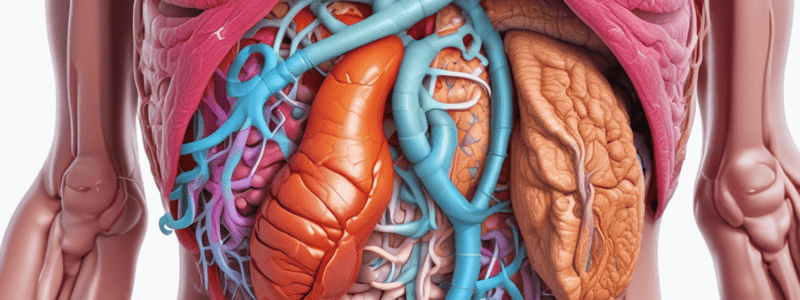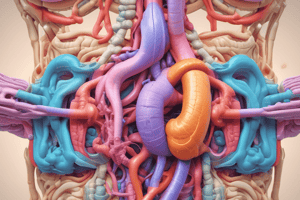Podcast
Questions and Answers
What is the function of intrinsic factor secreted in the small intestine?
What is the function of intrinsic factor secreted in the small intestine?
- Stimulates the release of digestive enzymes
- Enhances bile production
- Aids in the absorption of vitamin B12 (correct)
- Promotes water absorption
Which organ is responsible for producing bile salts to emulsify lipids for digestion?
Which organ is responsible for producing bile salts to emulsify lipids for digestion?
- Liver (correct)
- Stomach
- Pancreas
- Gallbladder
What is the main function of segmentation in the small intestine?
What is the main function of segmentation in the small intestine?
- Breaking down complex food molecules
- Propelling food rapidly
- Mixing chyme and digestive juices (correct)
- Absorbing nutrients
Which hormone stimulates the release of gastric acid in the stomach?
Which hormone stimulates the release of gastric acid in the stomach?
What is the main function of bicarbonate released by the pancreas?
What is the main function of bicarbonate released by the pancreas?
What is the purpose of peristalsis in the digestive system?
What is the purpose of peristalsis in the digestive system?
Which muscle is responsible for the voluntary removal of feces?
Which muscle is responsible for the voluntary removal of feces?
What is the primary function of the bacterial flora in the digestive system?
What is the primary function of the bacterial flora in the digestive system?
What is the main role of the liver in the digestive system?
What is the main role of the liver in the digestive system?
What is the primary function of bile in the small intestine?
What is the primary function of bile in the small intestine?
What is the main role of the pancreas in the digestive system?
What is the main role of the pancreas in the digestive system?
What is the primary function of the gallbladder in the digestive system?
What is the primary function of the gallbladder in the digestive system?
What is the primary function of the digestive system?
What is the primary function of the digestive system?
Which of the following is NOT a structure of the digestive system?
Which of the following is NOT a structure of the digestive system?
What is the function of the muscularis layer in the digestive tract?
What is the function of the muscularis layer in the digestive tract?
Which nervous system regulates digestive secretions and motility?
Which nervous system regulates digestive secretions and motility?
What is the function of the hepatic portal system?
What is the function of the hepatic portal system?
Which of the following is a function of saliva produced in the mouth?
Which of the following is a function of saliva produced in the mouth?
What is the main function of the upper esophageal sphincter?
What is the main function of the upper esophageal sphincter?
Which part of the stomach is responsible for storing undigested food and gases?
Which part of the stomach is responsible for storing undigested food and gases?
What is the primary function of parietal cells in the stomach?
What is the primary function of parietal cells in the stomach?
Which phase of gastric secretion is triggered by the sight, smell, taste, or thought of food?
Which phase of gastric secretion is triggered by the sight, smell, taste, or thought of food?
What is the most essential function of intrinsic factor in the stomach?
What is the most essential function of intrinsic factor in the stomach?
Where does mechanical digestion primarily occur in the small intestine?
Where does mechanical digestion primarily occur in the small intestine?
Which hormone initiates peristalsis and helps move chyme through the intestine?
Which hormone initiates peristalsis and helps move chyme through the intestine?
What is the function of segmentation in mechanical digestion in the small intestine?
What is the function of segmentation in mechanical digestion in the small intestine?
What is the main function of enteroendocrine cells in the stomach?
What is the main function of enteroendocrine cells in the stomach?
Study Notes
Overview of the Digestive System
- The digestive system breaks down food to release and absorb nutrients.
- The GI tract is approximately 25 feet long, from the mouth to the anus, and has four layers.
Structures of the Digestive System
- The pharynx, esophagus, stomach, small intestine, and large intestine make up the digestive system.
- Accessory digestive organs include teeth, tongue, salivary glands, liver, gallbladder, and pancreas.
Layers of the Digestive Tract
- Mucosa: a mucous membrane epithelium in contact with food.
- Submucosa: dense connective tissue between mucosa and muscularis, with blood and lymphatic vessels, and a collection of nerves called the submucosal plexus.
- Muscularis: inner circular layer and outer longitudinal layer in the small intestine, responsible for mechanical digestion, exposing food to more chemicals, and peristalsis.
- Serosa: the most superficial layer, only in the region inside the abdominal cavity, made of loose connective tissue holding the canal in place.
Enteric Nervous System
- Runs from the esophagus to the anus and is separated into two plexuses: myenteric for motility and submucosal for regulating digestive secretions.
- Autonomic nervous system: extrinsically innervates the alimentary canal, with sympathetic nerves restricting enteric neurons and parasympathetic nerves increasing GI secretion and motility.
Blood Supply
- Transports protein and carbohydrate to the liver through the hepatic portal system.
- Delivers nutrients and oxygen to organs of the alimentary canal, with 25% of blood being pumped into the arteries serving the intestines while resting and digesting.
Functions of the Mouth
- Ingests, chews, and mixes food.
- Begins chemical breakdown of carbohydrates and lipids.
- Moves food to the pharynx.
- Moistens and tastes food, cleans and lubricates teeth, and has antimicrobial activity.
Functions of the Pharynx
- Propels food to the esophagus.
- Lubricates food and passage.
Functions of the Esophagus
- Propels food to the stomach.
- Lubricates food and passage.
Functions of the Stomach
- Mixes food with gastric juices to form chyme.
- Begins chemical breakdown of proteins.
- Absorbs some fat-soluble substances.
- Stimulates protein-digesting enzymes and secretes intrinsic factor for vitamin B12 absorption in the small intestine.
Functions of the Small Intestine
- Mixes chyme and digestive juices.
- Propels food slowly.
- Absorbs macro and micro nutrients.
- Segmentation optimizes enzymatic activity.
Functions of the Large Intestine
- Further breaks down food residue.
- Absorbs residual water, electrolyte, and vitamins produced by enteric bacteria.
- Propels and eliminates feces.
- Food residue is concentrated and temporarily stored.
- Mucus eases passage of feces through the colon.
Functions of the Liver
- Produces bile salts to emulsify lipids for digestion and absorption.
Functions of the Gallbladder
- Stores, concentrates, and releases bile.
Functions of the Pancreas
- Produces digestive enzymes and bicarbonate.
- Bicarbonate helps to neutralize acidic chyme and provide an optimal environment for enzymatic activity.
Ingestion
- Entry of food into the alimentary canal through the mouth.
Swallowing
- Last voluntary act until defecation, involving propulsion and peristalsis.
Mechanical Digestion
- Physical process that does not change the chemical nature of food, exposes a larger surface area to digestion.
Chemical Digestion
- Breaking down complex food molecules into their building blocks.
Absorption
- Primarily occurs in the small intestine, taking nutrients into the bloodstream or lipids into the lymphatic system.
Defecation
- Undigested materials are removed from the body.
Neural Control
- Sensors for expansion of the stomach, food particles, liquid present, and nutrient type.
- Can activate glands and muscle.
- Two types of reflexes: short reflex (local stimulus and result) and long reflex (ANS and CNS reacting to stimuli outside the digestive tract).
Hormonal Control
- Gastrin stimulates the release of gastric acid.
- Secretin stimulates bicarbonate release from the pancreas.
- CCK stimulates pancreatic secretion of enzymes and bile from the liver and gallbladder.
- Gastric inhibitory peptide inhibits gastric secretion and slows gastric emptying and motility.
Studying That Suits You
Use AI to generate personalized quizzes and flashcards to suit your learning preferences.
Description
Test your knowledge on the structures and functions of the digestive system, including the gastrointestinal tract and accessory digestive organs. Learn about the layers of the GI tract and the purpose of each structure in the process of breaking down food to release and absorb nutrients.




